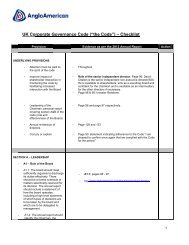The Anglo Environment Way: Volume I [PDF 1.45 ... - Anglo American
The Anglo Environment Way: Volume I [PDF 1.45 ... - Anglo American
The Anglo Environment Way: Volume I [PDF 1.45 ... - Anglo American
You also want an ePaper? Increase the reach of your titles
YUMPU automatically turns print PDFs into web optimized ePapers that Google loves.
Version 2 • March 2009 • Final
THE ANGLO ENVIRONMENT WAY<br />
CONTENTS<br />
volume 1: MANAGEMENT SYSTEM STANDARD<br />
INTRODUCTION 3<br />
ENVIRONMENTAL MANAGEMENT IN ANGLO AMERICAN 5<br />
OUR VISION 5<br />
OUR PRINCIPLES 5<br />
OUR POLICY 5<br />
THE ANGLO ENVIRONMENTAL MANAGEMENT FRAMEWORK 6<br />
VISIBLE LEADERSHIP 7<br />
CORPORATE ASSURANCE PROGRAMME 7<br />
OUR PRINCIPLES 7<br />
DOCUMENT HIERARCHY 8<br />
ENVIRONMENTAL STANDARDS 8<br />
Scope 9<br />
Application 9<br />
Management review 10<br />
ENVIRONMENTAL MANAGEMENT SYSTEM STANDARD 11<br />
PURPOSE 11<br />
SCOPE AND APPLICATION 11<br />
DEFINITIONS 11<br />
GENERAL REQUIREMENTS 11<br />
OPPORTUNITY IDENTIFICATION STAGE: EXPLORATION/ PROSPECTING 12<br />
EVALUATION STAGE: PROJECTS 13<br />
IMPLEMENTATION STAGE: DETAILED DESIGN, CONSTRUCTION AND COMMISSIONING 13<br />
OPERATIONAL STAGE 14<br />
Closure Stage: Decommissioning and Post-Closure 21<br />
SUPPORTING DOCUMENTATION 21<br />
2
THE ANGLO ENVIRONMENT WAY<br />
INTRODUCTION<br />
<strong>Anglo</strong> <strong>American</strong> plc owns and operates a range of businesses which, by virtue of their nature, scale and geographical locations, have<br />
significant environmental challenges.<br />
Our divisions and managed operations are committed to <strong>Anglo</strong> <strong>American</strong>’s “Good Citizenship: Our Business Principles”. To help us meet our<br />
commitments to the protection and management of the environment, <strong>Anglo</strong> <strong>American</strong> has developed the <strong>Anglo</strong> <strong>Environment</strong> <strong>Way</strong>.<br />
<strong>The</strong> <strong>Anglo</strong> <strong>American</strong> plc Executive Committee has endorsed and committed to the implementation of the <strong>Anglo</strong> <strong>Environment</strong> <strong>Way</strong> as the<br />
governing framework for the management of environmental impacts. <strong>The</strong> Board seeks assurance of compliance with the <strong>Anglo</strong> <strong>Environment</strong><br />
<strong>Way</strong> standards through regular self-assessments, peer review and third party audits.<br />
Under Revision<br />
3
THE ANGLO ENVIRONMENT WAY<br />
<strong>The</strong> table below highlights the focus of <strong>Volume</strong> 1 (this volume), and summarises the coverage of the <strong>Environment</strong>al Management System<br />
(EMS) Standard:<br />
VOLUME 2<br />
Lifecycle Stages<br />
EMS Standard – VOL. 1<br />
S&EIA Standard<br />
Water<br />
Performance Standards<br />
Air quality<br />
Mineral waste<br />
Non-mineral waste<br />
Hazardous<br />
substances<br />
Biodiversity<br />
Rehabilitation<br />
Mine closure<br />
Opportunity<br />
Identification<br />
Evaluation<br />
Project<br />
Implementation<br />
Operational<br />
Closure<br />
Exploration/ Prospecting<br />
Acquisitions - Due diligence<br />
Conceptual phase<br />
Projects Pre-feasibility phase<br />
Feasibility phase<br />
Detailed design and procurement<br />
Construction and commissioning<br />
Decommissioning<br />
Post-closure<br />
•<br />
• • •<br />
•<br />
x<br />
•<br />
•<br />
•<br />
•<br />
• • •<br />
• ••••• •<br />
x x x<br />
x<br />
x<br />
x<br />
x<br />
x<br />
x<br />
x<br />
x<br />
x<br />
x<br />
x<br />
x<br />
x<br />
x<br />
x<br />
x<br />
x<br />
x<br />
•<br />
•<br />
x<br />
•<br />
•<br />
• • •<br />
x<br />
x<br />
•<br />
x x x x x<br />
• • •<br />
x x x<br />
• • • •<br />
x<br />
x<br />
x x x x x x x<br />
• • • • • • x<br />
• • • • • •<br />
x<br />
Key:<br />
x<br />
Contains specific requirements.<br />
•<br />
Indirectly covered by general requirements.<br />
4
THE ANGLO ENVIRONMENT WAY<br />
ENVIRONMENTAL MANAGEMENT IN ANGLO AMERICAN<br />
Our vision<br />
<strong>The</strong> <strong>Anglo</strong> <strong>American</strong> <strong>Environment</strong>al Vision is to minimise harm to the environment<br />
by designing, operating and closing all of our operations in an environmentally<br />
responsible manner.<br />
We believe that robust management of environmental issues is a fundamental<br />
element of good overall operational management, and a source of competitive<br />
advantage. Poor management of environmental issues is inconsistent with <strong>Anglo</strong><br />
<strong>American</strong>’s values and long-term business interests.<br />
Our principles<br />
Underpinning this Vision are three fundamental principles:<br />
• Zero mindset: we shall apply the mitigation hierarchy of avoiding, minimising<br />
and mitigating environmental impacts arising from our activities, products<br />
and services;<br />
• No repeats: all necessary steps will be taken to learn from environmental impacts, incidents, audit findings and other non-conformances,<br />
to prevent their recurrence; and<br />
• Non-negotiable standards and rules: common, non-negotiable <strong>Environment</strong>al Performance Standards and Procedures shall be applied<br />
throughout the Group as a minimum requirement.<br />
Our policy<br />
We hold our leaders accountable for the environmental management of our activities.<br />
We expect our line managers and supervisors to provide effective leadership in environmental management whilst recognising that<br />
environmental management is the responsibility of all who work for us.<br />
Managers of every business or operation are responsible for the full implementation of the <strong>Anglo</strong> <strong>Environment</strong>al Management Framework and<br />
participation in the <strong>Anglo</strong> Assurance Programme. This requires:<br />
• the allocation of appropriate resources and the provision of training, education, consultation and auditing to ensure compliance;<br />
• the development, implementation and maintenance of environmental policies, programmes and procedures; and<br />
• effective environmental impact identification, assessment and control, designed to achieve proactive management of our activities,<br />
products and services.<br />
We shall conserve and protect environmental resources through, amongst others, the efficient use of energy and water, minimising waste<br />
and reducing pollution.<br />
We shall demonstrate active stewardship of land, freshwater systems and biodiversity with which we interact.<br />
We respect people’s culture and heritage.<br />
We shall comply with environmental legislation and other requirements to which we subscribe, and develop a culture of continual<br />
improvement.<br />
We commit to open communication with our employees, local communities, contractors, suppliers, investors, business partners and other<br />
interested third parties to encourage an environmentally responsible culture that reflects the intent of this policy.<br />
This policy will be reviewed at appropriate intervals and revised where necessary to keep it current.<br />
Cynthia Carroll<br />
Chief Executive, <strong>Anglo</strong> <strong>American</strong> plc<br />
September 2007<br />
5
THE ANGLO ENVIRONMENT WAY<br />
THE ANGLO ENVIRONMENTAL MANAGEMENT FRAMEWORK<br />
<strong>The</strong> <strong>Anglo</strong> <strong>Environment</strong>al Management Framework defines the roles and responsibilities of the corporate centre and divisional organisations.<br />
<strong>The</strong> corporate function defines, communicates, and reviews environmental management requirements in relation to the Vision, Leadership,<br />
Principles, Policy and Standards. <strong>The</strong> divisional organisations implement and incorporate the corporate requirements into business-specific<br />
programmes and working practices.<br />
LEADERSHIP<br />
• AAplc Vision and Principles<br />
• AAplc Policy and Standards<br />
AAplc<br />
• Executive Board<br />
• S & SD Committee<br />
• Corporate SHE<br />
• Peer review<br />
• Third party<br />
Assurance<br />
Corporate<br />
<strong>The</strong> corporate centre will define and communicate what is required<br />
– including clear non-negotiable standards. This will require inter<br />
alia resourcing, communication, setting of Executive KPIs and an<br />
overarching environmental management plan.<br />
Divisions<br />
Divisions<br />
<strong>The</strong> Divisions will implement the corporate policy and add their own<br />
business-specific standards and rules to those of AAplc. This will also<br />
require resourcing, communication, setting of business-specific KPIs and<br />
operational environmental management plans.<br />
LEADERSHIP<br />
Operational Locations<br />
Audits<br />
• AAplc Vision and Principles<br />
• Corporate and Divisional<br />
Policy and Standards<br />
(including Contractors)<br />
Procedures<br />
• Self-assessment<br />
• Divisional<br />
• Third party<br />
• Behavioural<br />
Training<br />
Behaviour<br />
6
THE ANGLO ENVIRONMENT WAY<br />
Visible Leadership<br />
All levels of management have a responsibility to abide by the <strong>Environment</strong>al<br />
Vision, Principles and Policy, which must be embraced and embedded into the<br />
organisation.<br />
Executives and senior management are ultimately accountable for the management<br />
of environmental issues. <strong>The</strong>y must lead by example and demonstrate the desired<br />
leadership behaviours that will drive continual improvement in environmental<br />
performance. Management must set non-negotiable, high standards for<br />
environmental management, and correct wrong behaviours or situations that could<br />
cause unplanned or increased adverse impacts on the environment. Particular<br />
emphasis is needed to ensure that adverse impacts are avoided or minimised,<br />
lessons are learned from incidents and all necessary actions are taken to prevent<br />
repeats.<br />
Executives, managers and first-line supervisors must demonstrate through visibly felt leadership that environmental issues are given the<br />
same priority, throughout the lifecycle of a business, as other key business priorities. This shall include participating in environmental<br />
programmes, audits and reviews, and engaging with employees, contractors and other stakeholders.<br />
Corporate Assurance Programme<br />
<strong>The</strong> Executive Committee seeks assurance of compliance with the <strong>Environment</strong> <strong>Way</strong> and its Standards, and with the process of continual<br />
improvement. <strong>The</strong> corporate assurance programmes have been developed as a means of ensuring that fundamentally sound, risk-based<br />
management systems are in place at all operations. Furthermore, the assurance programmes assist in building core competence and acts as<br />
a catalyst for learning and sharing across <strong>Anglo</strong> <strong>American</strong>.<br />
Our Principles<br />
<strong>Anglo</strong> <strong>American</strong><br />
<strong>Environment</strong>al Principles<br />
Zero mindset<br />
We believe that we can avoid,<br />
minimise and mitigate environmental<br />
impacts arising from our operations.<br />
We are all responsible for correcting<br />
unacceptable practices and situations<br />
in the workplace that could adversely<br />
impact the environment.<br />
No repeats<br />
All environmental incidents and<br />
poor environmental practices will<br />
be investigated to determine what<br />
happened and why.<br />
To learn from environmental<br />
incidents, and to take all necessary<br />
steps to prevent their recurrence.<br />
Simple, non-negotiable standards<br />
and rules<br />
We will adopt a common, simple<br />
set of non-negotiable standards and<br />
rules throughout the Group.<br />
Divisional line management at all<br />
levels has the responsibility of<br />
implementing and maintaining the<br />
standards and rules.<br />
7
THE ANGLO ENVIRONMENT WAY<br />
Document hierarchy<br />
<strong>The</strong> <strong>Anglo</strong> <strong>Environment</strong>al Management Framework consists of a set of hierarchical documents, with a mandatory requirement to implement<br />
the content of the high-level documentation, while the guidelines are advisory.<br />
<strong>Anglo</strong> <strong>American</strong> “Good Citizenship Business Principles”<br />
<strong>Anglo</strong> <strong>American</strong> Values<br />
<strong>Environment</strong>al Management in<br />
<strong>Anglo</strong> <strong>American</strong><br />
Vision<br />
Principles<br />
Policy<br />
<strong>Anglo</strong> <strong>American</strong> Management<br />
System Standard<br />
MANDATORY<br />
to all managed<br />
businesses<br />
<strong>Anglo</strong> <strong>American</strong> <strong>Environment</strong>al<br />
Performance Standards<br />
<strong>Anglo</strong> <strong>American</strong><br />
<strong>Environment</strong>al Procedures<br />
<strong>Anglo</strong> <strong>American</strong><br />
Guidelines and Toolboxes<br />
ADVISORY<br />
to all managed<br />
businesses<br />
Divisional <strong>Environment</strong>al Policy<br />
Operational Policy, Procedures, Etc.<br />
MANDATORY<br />
to all sites and operations<br />
controlled by the relevant<br />
Business Unit<br />
<strong>Environment</strong>al Standards<br />
<strong>Anglo</strong> has developed Principles and Policy, an <strong>Environment</strong>al Management System (EMS) Standard, a Social and <strong>Environment</strong>al Impact<br />
Assessment (S&EIA) Standard, and a number of <strong>Environment</strong>al Performance Standards that cover key management areas (e.g. water, air,<br />
biodiversity, etc.). <strong>The</strong>se Standards are mandatory, high-level requirements set at corporate level. <strong>The</strong>y support the <strong>Anglo</strong> <strong>Environment</strong>al<br />
Vision, Principles and Policy, and outline the required approach to avoiding or minimising the potential adverse environmental impacts<br />
associated with our activities. <strong>The</strong> Standards are supported by detailed procedures and guidelines.<br />
8
THE ANGLO ENVIRONMENT WAY<br />
<strong>The</strong> objectives of the Standards are to:<br />
• Support the realisation of the “Good Citizenship: Our Business Principles” and our <strong>Environment</strong>al Vision, Principles and Policy;<br />
• Provide a risk/ opportunity-based management strategy that is consistent with ISO 14001;<br />
• Provide clear environmental performance criteria against which environmental management across the Group can be measured and<br />
audited; and<br />
• Provide a uniform basis for the provision of assurance and from which to drive continual improvement across the Group.<br />
Scope<br />
<strong>The</strong> <strong>Anglo</strong> <strong>Environment</strong> <strong>Way</strong> applies to all managed activities across the world,<br />
which includes:<br />
• owned and/or operated sites/ facilities;<br />
• ‘greenfields’ and ‘brownfields’ projects;<br />
• mergers and acquisitions – to assist in the identification of potential<br />
environmental risks and liabilities prior to them becoming part of <strong>Anglo</strong><br />
<strong>American</strong>;<br />
• divestments; and<br />
• activities of contractors, suppliers, visitors on <strong>Anglo</strong> sites or under <strong>Anglo</strong><br />
management.<br />
Where <strong>Anglo</strong> <strong>American</strong> has an equity stake, or where significant group assets<br />
are involved, these Standards shall be made available to independently managed<br />
operations, via our representatives on the relevant Boards, and to joint ventures,<br />
to encourage their application and improvement in environmental management.<br />
In relation to the above, the Standards apply to:<br />
• all our activities that have the potential to positively or negatively impact the environment, and<br />
• the entire life cycle of our operations from exploration through to project evaluation, design, operation, decommissioning, closure and<br />
post-closure.<br />
Application<br />
<strong>Anglo</strong> <strong>American</strong> is committed to managing its environmental aspects, impacts and risks through adherence to the internationally recognised<br />
ISO 14001:2004 EMS Standard. <strong>The</strong> <strong>Anglo</strong> EMS Standard contains some additional requirements, which are designed to complement those<br />
contained in ISO 14001. <strong>The</strong> ISO 14001 clauses, to which the complementary requirements link, have been quoted in the EMS Standard<br />
so as to provide the context. ISO 14001 together with the <strong>Anglo</strong> EMS Standard provide the basis for the development, enhancement and<br />
application of comprehensive, integrated EMSs throughout our operations.<br />
<strong>The</strong> S&EIA Standard aims to ensure that all <strong>Anglo</strong> <strong>American</strong> projects proactively consider social and environmental matters in their planning<br />
and decision-making.<br />
<strong>The</strong> <strong>Environment</strong>al Performance Standards contain additional requirements for key management areas, which apply over and above the <strong>Anglo</strong><br />
EMS and S&EIA Standards. <strong>The</strong>y prescribe the minimum level of performance that is expected to be achieved in these areas, where<br />
there is an environmental risk or opportunity. Where there is no risk or opportunity, this needs to be demonstrated through a<br />
documented risk assessment. <strong>The</strong> <strong>Environment</strong>al Performance Standards will then not apply. In other words a risk-based approach<br />
is applied to the application of the environmental performance standards.<br />
9
THE ANGLO ENVIRONMENT WAY<br />
<strong>The</strong> <strong>Environment</strong>al Standards cover the following lifecycle stages:<br />
Opportunity<br />
Identification<br />
Evaluation<br />
Project Implementation<br />
Operational<br />
Closure<br />
Exploration/ Prospecting<br />
Acquisitions - Due diligence<br />
Conceptual phase<br />
Projects<br />
Pre-feasibility phase<br />
Feasibility phase<br />
Detailed design and procurement<br />
Construction and commissioning<br />
Decommissioning<br />
Post-closure<br />
<strong>The</strong> <strong>Environment</strong>al Standards contain requirements relating to the following management topics:<br />
Planning<br />
Implementation<br />
Checking<br />
Policy, leadership and commitment<br />
Administrative/ Project management<br />
Stakeholder engagement<br />
<strong>Environment</strong>al aspects<br />
Identification and selection of alternatives<br />
<strong>Environment</strong>al characterisation/ Description<br />
Legal and other requirements<br />
Scope<br />
Objectives and targets<br />
Risk/ Impact assessment<br />
Plan/ Design environmental programme(s) and operational controls<br />
Resources, roles, responsibility and authority<br />
Competence, training and awareness<br />
Communication and stakeholder engagement<br />
Implement environmental programme(s) and operational controls<br />
Maintenance and inspections<br />
Emergency preparedness and response<br />
Monitoring and performance measurement<br />
Non-conformity, corrective action and prevention<br />
Records<br />
Reports<br />
Audits<br />
Reviews<br />
Management review<br />
<strong>The</strong> <strong>Environment</strong> <strong>Way</strong> and its <strong>Environment</strong>al Standards will be reviewed annually at corporate level to ensure that they remain current and<br />
valid, and will be revised and reissued as appropriate.<br />
10
THE ANGLO ENVIRONMENT WAY | MANAGEMENT SYSTEM STANDARD<br />
ENVIRONMENTAL MANAGEMENT SYSTEM STANDARD<br />
Purpose<br />
<strong>The</strong> purpose of this standard is to ensure that all <strong>Anglo</strong> <strong>American</strong> managed operations implement a formal <strong>Environment</strong>al Management System<br />
(EMS) to avoid or mitigate potential adverse impacts on the environment.<br />
Scope and Application<br />
This standard and supporting documentation:<br />
• Contains additional requirements for the operational stage to complement those prescribed by ISO 14001:2004.<br />
• Contains the minimum EMS requirements for the exploration, implementation and closure stages. (<strong>The</strong> exploration stage requirements<br />
complement the Exploration SHEC-list.)<br />
• Applies to all on-site activities and off-site, ancillary activities for which <strong>Anglo</strong> <strong>American</strong> managed operations have responsibility.<br />
Definitions<br />
<strong>The</strong> definitions in ISO 14001: 2004 Clause 3 apply.<br />
Also refer to the definitions in the S&EIA and Performance Standards.<br />
General Requirements<br />
All <strong>Anglo</strong> <strong>American</strong> projects and managed operations shall:<br />
Competence,<br />
training and<br />
awareness<br />
Employ suitably qualified and experienced specialists to:<br />
• interpret the legal, regulatory and other environmental requirements;<br />
• undertake the necessary investigations and test work; and<br />
• plan/ design the environmental programmes and operational controls for facilities that could have<br />
significant adverse environmental impacts, products or services or are needed to prevent such<br />
impacts.<br />
Employ staff and contractors that are competent to perform their activities in an environmentally<br />
responsible manner.<br />
11
MANAGEMENT SYSTEM STANDARD | THE ANGLO ENVIRONMENT WAY<br />
Opportunity Identification Stage: Exploration/ Prospecting<br />
All prospecting/ exploration activities under <strong>Anglo</strong> <strong>American</strong> management control shall:<br />
Administrative/<br />
Project management<br />
<strong>Environment</strong>al<br />
aspects<br />
<strong>Environment</strong>al<br />
characterisation/<br />
description<br />
Legal and other<br />
requirements<br />
Risk/ Impact<br />
assessment<br />
<strong>Environment</strong>al<br />
programme(s) and<br />
operational controls<br />
Resources, roles,<br />
responsibility and<br />
authority<br />
Stakeholder<br />
engagement<br />
Monitoring, records,<br />
reports, audits and<br />
reviews<br />
Obtain the required environmental approvals prior to commencing with exploration.<br />
Characterise/ Classify the materials disturbed by the exploration activities to establish their pollution<br />
potential when exploration involves intrusive activities, such as drill testing, bulk sampling or trial mining.<br />
Characterise, in general terms, the baseline environment within the area that could be impacted on by the<br />
planned exploration activities, by:<br />
• noting and recording, possibly using photographs, the condition of the area prior to activities; and<br />
• identifying land owners, users, overseers, and/or administrators.<br />
Undertake detailed baseline studies, as for projects {refer to S&EIA Standard}, when prospecting in<br />
sensitive areas and/or when the activities will result in extensive disturbance of (relatively) pristine land.<br />
Prior to mobilising, conduct a review to determine the legal and other requirements applicable to<br />
exploration.<br />
Prior to commencing with the exploration activities, use the Exploration SHEC-List (on the Source under<br />
Sustainable Development) to screen, rate the significance of and analyse issues of concern.<br />
Assess impacts, as for projects {refer to S&EIA Standard}, when prospecting in sensitive areas and/or<br />
when the activities will result in extensive disturbance of (relatively) pristine land.<br />
Use the Exploration SHEC-List to identify and record the management actions to be implemented to<br />
reduce the identified significant issues to acceptable levels or to enhance the positive effects.<br />
Implement the Management Action Plan developed using the Exploration SHEC-List.<br />
Use the Exploration SHEC-List to prepare an environmental management budget for the exploration<br />
activities.<br />
Use the Exploration SHEC-List to:<br />
• identify and analyse stakeholders who may be affected by, interested in, or able to influence the<br />
exploration activities;<br />
• guide engagement on issues such as access to land, compensation and/or rehabilitation requirements<br />
for disturbed areas; and<br />
• foster constructive relations with government, communities and other relevant stakeholders.<br />
Undertake environmental monitoring, if required, until the site is officially handed over to the owners,<br />
users, overseers, and/or administrators.<br />
12
THE ANGLO ENVIRONMENT WAY | MANAGEMENT SYSTEM STANDARD<br />
Evaluation Stage: Projects<br />
{Refer to the S&EIA and Performance Standards.}<br />
Implementation Stage: Detailed Design, Construction and Commissioning<br />
During the implementation stage all projects shall:<br />
Administrative/<br />
Project management<br />
<strong>Environment</strong>al<br />
aspects<br />
Characterise/<br />
Describe the<br />
environment<br />
Legal and other<br />
Risk/ Impact<br />
assessment<br />
Plan/ Design<br />
environmental<br />
programme(s) and<br />
operational controls<br />
Stakeholder<br />
engagement<br />
Implement<br />
environmental<br />
programme(s) and<br />
operational controls<br />
Monitor, record,<br />
report, review,<br />
audit<br />
Commence with the implementation of an EMS, or integration into an existing EMS, focusing initially on<br />
the construction phase.<br />
Ensure that:<br />
• any modifications to the design(s) are approved by the designers;<br />
• facilities, that could have significant adverse impacts or are needed to prevent such impacts, are<br />
constructed by suitably qualified contractors and supervised by the designers to ensure that they are<br />
built according to the design, and not commissioned prematurely or incorrectly;<br />
• major contractors compile Social and <strong>Environment</strong>al Management Plans (S&EMPs) that are applicable<br />
to all subcontractors and aligned with the project’s S&EMPs {refer to the S&EIA Standard}; and<br />
• the owner/ operator receives from the project team/ designers all quality control data, the as-built<br />
drawings, and the approved operating manuals, procedures and codes of practice.<br />
If necessary, update the aspects register and inventory of inputs and outputs {refer to the S&EIA<br />
Standard}.<br />
Undertake any additional test work or modelling required to support the development of the<br />
environmental programme(s) and operational controls.<br />
Undertake any additional baseline data collection that may be required {refer to the S&EIA Standard}.<br />
Update the register of legal and other requirements as new requirements are identified {refer to the S&EIA<br />
Standard}.<br />
Complete risk/impact assessments.<br />
See Operational stage, below.<br />
Complete the detailed engineering taking into account feasibility peer review comments/<br />
recommendations, any other independent peer review comments, and any further test work or fieldwork<br />
undertaken.<br />
Clearly state design objectives and operating philosophies in design reports.<br />
Develop commissioning plans, which also consider potential commissioning challenges, for facilities that<br />
could have significant adverse impacts or are needed to prevent such impacts and ensure that there are<br />
adequate resources to implement them.<br />
See Operational stage, below.<br />
Ensure that facilities that could have significant adverse impacts or are needed to prevent such impacts<br />
are commissioned in strict accordance with designs and commissioning plans.<br />
Initiate the environmental inspections and monitoring, as for the Operational stage (see below).<br />
Record and report environmental data as for the Operational stage (see below).<br />
13
MANAGEMENT SYSTEM STANDARD | THE ANGLO ENVIRONMENT WAY<br />
Operational Stage<br />
All <strong>Anglo</strong> <strong>American</strong> managed operations shall:<br />
Administrative/<br />
Project management<br />
Policy, leadership<br />
and commitment<br />
Define and document the scope of an EMS.<br />
Develop, document, implement, maintain and review an EMS, which shall be certified to ISO 14001:2004<br />
and reflect the <strong>Anglo</strong> <strong>American</strong> <strong>Environment</strong>al Vision, Principles and Policy.<br />
Apply ISO 14001 Clause 4.2 and A.2, including:<br />
[…] define the organisation’s environmental policy and ensure that […] it is appropriate to the nature,<br />
scale and environmental impacts of its activities, products and services.<br />
Establish, implement and maintain a local environmental policy that is in line with the Corporate<br />
environmental policy.<br />
<strong>Environment</strong>al<br />
aspects<br />
Apply ISO 14001 Clause 4.3.1 and A.3.1, including:<br />
[…] identify the environmental aspects of its activities, products and services […] that it can control<br />
and those that it can influence taking into account planned or new developments, or new or modified<br />
activities, products and services.<br />
[…] determine those aspects that have or can have significant impact(s) on the environment (i.e.<br />
significant environmental aspects).<br />
[…] document this information and keep it up-to-date.<br />
[…] consider normal and abnormal operating conditions, shut-down and start-up conditions, as well as<br />
reasonably foreseeable emergency situations.<br />
[…] identify the environmental aspects […] associated with its current and relevant-past activities,<br />
products and services, planned or new developments, or new or modified activities, products and services.<br />
Establish and maintain an up-to-date register of environmental aspects.<br />
Review and, if necessary, update the aspects register, including the inventory of inputs and outputs, at<br />
least annually, or more frequently if operational changes occur.<br />
Characterise/ Classify the properties of and, where possible, quantify the inputs to (e.g. reagents, water<br />
and energy), outputs from (e.g. wastes, emissions and effluents), and materials to be disturbed by (e.g.<br />
excavations) aspects throughout the operation’s lifecycle. As appropriate:<br />
• conduct test work and/or modelling;<br />
• classify using local regulatory criteria;<br />
• determine whether or not they are hazardous; and<br />
• establish the risks (e.g. pollution potential) that they pose to the environment and prioritise<br />
accordingly.<br />
Perform ongoing test work to characterise the inputs, outputs and/or materials disturbed by mining.<br />
14
THE ANGLO ENVIRONMENT WAY | MANAGEMENT SYSTEM STANDARD<br />
Characterise/<br />
Describe the<br />
environment<br />
Legal and other<br />
requirements<br />
Undertake any further detailed baseline data collection that may be required.<br />
Update baseline data for areas not yet disturbed by mining, using the results of ongoing environmental<br />
monitoring.<br />
Apply ISO 14001 Clause 4.3.2 and A.3.2, including:<br />
[…] identify and have access to the applicable legal requirements and other requirements to which the<br />
organisation subscribes related to its environmental aspects, and […] determine how these requirements<br />
apply to its environmental aspects.<br />
(<strong>The</strong> host-country legislation applies as a minimum requirement, and is only superseded by other<br />
requirements that are more stringent, and not in conflict with the host-country legislation.)<br />
Establish and maintain an up-to-date register of the legal and other requirements.<br />
Periodically – in line with anticipated rate of legislative changes – review the register of legal and other<br />
environmental requirements.<br />
<strong>The</strong> <strong>Anglo</strong> <strong>American</strong> <strong>Environment</strong>al Performance Standards (<strong>Volume</strong> 2 of the AEW) are mandatory “other<br />
requirements”.<br />
Objectives and<br />
targets<br />
Apply ISO 14001 Clause 4.3.3 and A.3.3, including:<br />
[…] establish, implement and maintain documented environmental objectives and targets, at relevant<br />
functions and levels within the organisation.<br />
<strong>The</strong> objectives and targets shall be measurable, where practicable, and consistent with the environmental<br />
policy, including the commitments to prevention of pollution, to compliance with applicable legal<br />
requirements and with other requirements to which the organisation subscribes, and to continual<br />
improvement.<br />
When establishing and reviewing its objectives and targets, […] take into account the legal requirements<br />
and other requirements to which the organisation subscribes, and its significant environmental aspects. It<br />
shall also consider its technological options, its financial, operational and business requirements, and the<br />
views of interested parties.<br />
Update the objectives and targets to accommodate changes to the legal and other requirements and/or<br />
monitoring results.<br />
Risk/ Impact<br />
assessment<br />
Plan/ Design<br />
environmental<br />
programme(s) and<br />
operational controls<br />
Establish and maintain an up-to-date register of environmental impacts.<br />
Establish, implement and maintain a procedure whereby the impacts register is reviewed and updated at<br />
least annually, or more frequently if operational changes occur.<br />
Reassess impacts/ risks using real monitoring data to re-calibrate models, etc. <strong>The</strong> frequency of these<br />
reassessments shall reflect the significance of the potential impacts.<br />
Apply ISO 14001 Clause 4.3.3, A.3.3, 4.4.6 and A.4.6, including:<br />
[…] establish […] and maintain programme(s) for achieving its objectives and targets.<br />
[…] identify and plan those operations that are associated with the identified significant environmental<br />
aspects consistent with its environmental policy, objectives and targets, in order to ensure that they are<br />
carried out under specified conditions […].<br />
[…] address planning, design, construction, commissioning, operation and, at the appropriate time<br />
determined by the organisation, decommissioning.<br />
[…] evaluate those of its operations that are associated with its identified significant environmental<br />
aspects and ensure that they are conducted in a way that will control or reduce the adverse impacts<br />
associated with them, in order to fulfil the requirements of its environmental policy and meet its<br />
objectives and targets. This should include all parts of its operations, including maintenance activities.<br />
15
MANAGEMENT SYSTEM STANDARD | THE ANGLO ENVIRONMENT WAY<br />
Ensure that the programme(s) and operational controls:<br />
• take cognisance of guidance provided in <strong>Anglo</strong> <strong>American</strong> Guidelines and Toolboxes;<br />
• cover all the applicable lifecycle stages, including exploration and post-closure; and<br />
• address both negative (avoidance or mitigation) and positive (enhancement) aspects/ impacts.<br />
Resources, roles,<br />
responsibility and<br />
authority<br />
Apply ISO 14001 Clause 4.3.3, 4.4.1 and A.4.1, including:<br />
Programme(s) shall include<br />
a) designation of responsibility for achieving objectives and targets at relevant functions and levels of<br />
the organisation, and<br />
b) the means and time-frame by which they are to be achieved.<br />
[…] ensure the availability of resources essential to establish, implement, maintain and improve<br />
the environmental management system. Resources include human resources and specialised skills,<br />
organisational infrastructure, technology and financial resources.<br />
Roles, responsibilities and authorities shall be defined, documented and communicated in order to<br />
facilitate effective environmental management.<br />
<strong>Environment</strong>al roles and responsibilities therefore should not be seen as confined to the environmental<br />
management function, but can also cover other areas of an organisation, such as operational management<br />
or staff functions other than environmental.<br />
[…] ensure that appropriate resources, such as organisational infrastructure, are provided to ensure<br />
that the environmental management system is established, implemented and maintained. Examples of<br />
organisational infrastructure include buildings, communication lines, underground tanks, drainage, etc.<br />
Provide adequate financial resources in budgets for environmental management and monitoring.<br />
Develop an organisational structure for environmental management.<br />
Designate responsibility for achieving objectives and targets to all appropriate personnel, including senior<br />
management, line management, employees and contractors.<br />
Ensure that executives, managers, employees and contractors understand their responsibility to refuse<br />
to allow work to be undertaken or continued where conflict exists between the potential for significant<br />
adverse environmental risks/ impacts, and other business priorities.<br />
Allocate roles and responsibilities for environmental management, including emergency preparedness and<br />
response, as part of the Performance Agreements (or site equivalent) of the environmental and other<br />
personnel.<br />
Include the relevant <strong>Anglo</strong> <strong>American</strong> environmental performance requirements in all procurement contracts<br />
and other contractor and business partner arrangements.<br />
Ensure that all on-site and transport contractors comply with all on- and off-site licensing, and permitting,<br />
and their EMSs reflect the ISO14001 requirements.<br />
Performance incentives<br />
• Set as a priority for line managers the management of agreed environmental objectives and targets<br />
and include this as a Key Performance Area (KPA) in their performance contracts.<br />
• Ensure that executives and managers develop a formal process to recognise, reinforce and reward<br />
desired environmental outcomes.<br />
16
THE ANGLO ENVIRONMENT WAY | MANAGEMENT SYSTEM STANDARD<br />
Competence,<br />
training and<br />
awareness<br />
Apply ISO 14001 Clause 4.4.2 and A.4.2, including:<br />
[…] ensure that any person(s) performing tasks for it or on its behalf that have the potential to cause<br />
a significant environmental impact(s) identified by the organisation is (are) competent on the basis of<br />
appropriate education, training or experience, and shall retain associated records.<br />
[…] identify training needs associated with its environmental aspects and its environmental management<br />
system. It shall provide training or take other action to meet these needs, and shall retain associated<br />
records.<br />
<strong>The</strong> organisation shall establish, implement and maintain a procedure(s) to make persons working for it or<br />
on its behalf aware of<br />
a) the importance of conformity with the environmental policy and procedures and with the<br />
requirements of the environmental management system,<br />
b) the significant environmental aspects and related actual or potential impacts associated with their<br />
work, and the environmental benefits of improved personal performance,<br />
c) their roles and responsibilities in achieving conformity with the requirements of the environmental<br />
management system, and<br />
d) the potential consequences of departure from specified procedures.<br />
Employ staff and contractors that are competent to perform their activities in an environmentally<br />
responsible manner.<br />
Consider the results of the aspect identification and risk/ impact assessments when establishing<br />
competence, training and awareness requirements.<br />
Provide appropriate training, refresher training, and coaching to personnel with roles and responsibilities<br />
for environmental management.<br />
Communication<br />
and stakeholder<br />
engagement<br />
Apply ISO 14001 Clause A.4.1, 4.2, 4.4.3, A4.3 and 4.4.6, including:<br />
It is also important that the key environmental management system roles and responsibilities are well<br />
defined and communicated to all persons working for or on behalf of the organisation.<br />
[…] define the organisation’s environmental policy and ensure that […] it is available to the public.<br />
[…] establish, implement and maintain a procedure(s) for<br />
a) internal communication among the various levels and functions of the organisation,<br />
b) receiving, documenting and responding to relevant communication from external interested parties.<br />
[…] establish and implement a method(s) for […] external communication.<br />
[… communicate] applicable procedures and requirements to suppliers, including contractors.<br />
Implement a process for effective engagement (communication, consultation and/or participation) with<br />
the relevant stakeholders in matters relating to the environment, including lessons learnt, good practices<br />
and opportunities for improvement.<br />
Communicate to all relevant personnel and contractors the:<br />
• results of the aspect identification and risk/ impact assessments;<br />
• legal and other requirements;<br />
• objectives and targets;<br />
• requirement to report to management any inappropriate environmental practices or conditions; and<br />
• environmental management measures, such as the formal management of change programme, and<br />
emergency preparedness and response procedures.<br />
Proactively engage with stakeholders to ensure that:<br />
• they are aware of matters relating to the environment and the potential impacts that could arise from<br />
the operations;<br />
• their perceptions and opinions are considered;<br />
• good relationships are fostered;<br />
• they have the opportunity to contribute to the development of management measures; and<br />
• the dissemination of monitoring results are open and transparent.<br />
17
MANAGEMENT SYSTEM STANDARD | THE ANGLO ENVIRONMENT WAY<br />
Establish and maintain an up-to-date register of stakeholders and record of communications.<br />
Establish a Stakeholder/ Community Engagement Plan(s), which elaborates on the ongoing engagement<br />
process, with the appropriate level of engagement applicable to the various stakeholder groups.<br />
Maintain, expand or initiate partnerships, as required.<br />
Implement<br />
environmental<br />
programme(s) and<br />
operational controls<br />
Apply ISO 14001 Clause 4.3.3, A.3.3, 4.4.6 and A.4.6, including:<br />
[…] implement […] programme(s) for achieving its objectives and targets.<br />
[… implement] procedure(s) to control situations where their absence could lead to deviation from the<br />
environmental policy, objectives and targets […].<br />
[… implement] procedures related to the identified significant environmental aspects […].<br />
Implement the environmental programme(s) and operational controls, including emergency preparedness<br />
and response procedures, community engagement plan(s) and the formal management of change<br />
programme.<br />
Ensure that any modifications to design(s) are approved by the design engineer.<br />
Maintenance and<br />
inspections<br />
Apply ISO 14001 Clause 4.5.1 and A.5.1, including:<br />
[…] ensure that calibrated or verified monitoring and measurement equipment is used and maintained and<br />
shall retain associated records.<br />
When necessary to ensure valid results, measuring equipment should be calibrated or verified at<br />
specified intervals, or prior to use, against measurement standards traceable to international or national<br />
measurement standards. If no such standards exist, the basis used for calibration should be recorded.<br />
Periodically test, calibrate and obtain certification for abatement, control and monitoring equipment/<br />
devices, as determined by the manufacturers’ requirements and/or national or international standards.<br />
Document and retain records of the results of calibration and maintenance activities for appropriate<br />
periods.<br />
Develop, document and implement formal site/area maintenance and inspection programmes. Record and<br />
report any deficiencies noted. Track and close out the measures to address the deficiencies.<br />
Emergency<br />
preparedness and<br />
response<br />
Apply ISO 14001 Clause 4.4.4 and A.4.7, including<br />
[…] establish, implement and maintain a procedure(s) to identify potential emergency situations and<br />
potential accidents that can have an impact(s) on the environment and how it will respond to them.<br />
[…] respond to actual emergency situations and accidents and prevent or mitigate associated adverse<br />
environmental impacts.<br />
[…] periodically test [emergency preparedness and response] procedures, where practicable.<br />
18
THE ANGLO ENVIRONMENT WAY | MANAGEMENT SYSTEM STANDARD<br />
Monitoring<br />
Apply ISO 14001 Clause 4.5.1 and A.5.1, including:<br />
[…] establish, implement and maintain a procedure(s) to monitor and measure, on a regular basis, the<br />
key characteristics of its operations that can have a significant environmental impact.<br />
[… monitor] conformity with the organisation’s environmental objectives and targets.<br />
Prepare and implement a detailed environmental monitoring plan, which includes post-closure monitoring.<br />
Set in place appropriate monitoring for the assessment of the operational aspects and impacts, to:<br />
• confirm that facilities are being operated within the required parameters;<br />
• confirm the effectiveness of the management measures;<br />
• assess performance against the objectives and targets, which encompass the legal and other<br />
requirements; and<br />
• ensure that risks/ impacts are avoided or minimised, and there are no repeats of incidents.<br />
Monitor the objectives and targets over defined time periods to confirm the effectiveness of the<br />
operational controls that have been implemented.<br />
Non-conformity,<br />
corrective action<br />
and preventive<br />
action<br />
Apply ISO 14001 Clause 4.5.3 and A.5.3, including:<br />
[…] Establish, implement and maintain a procedure(s) for dealing with actual and potential nonconformity(ies)<br />
and for taking corrective action and preventive action. <strong>The</strong> procedure(s) shall define<br />
requirements for<br />
a) identifying and correcting non-conformity(ies) and taking action(s) to mitigate their environmental<br />
impacts,<br />
b) investigating non-conformity(ies), determining their cause(s) and taking actions in order to avoid<br />
their recurrence,<br />
c) evaluating the need for action(s) to prevent non-conformity(ies) and implementing appropriate<br />
actions designed to avoid their occurrence,<br />
d) recording the results of corrective action(s) and preventive action(s) taken, and<br />
e) reviewing the effectiveness of corrective action(s) and preventive action(s) taken.<br />
Actions taken shall be appropriate to the magnitude of the problems and the environmental impacts<br />
encountered.<br />
Develop and implement formal systems for the reporting, investigation, close-out (including management<br />
sign-off) and communication of environmental non-conformances and incidents.<br />
Formally review systems, procedures and work practices following an environmental legal nonconformance<br />
or significant incident (level II or III) to prevent a recurrence.<br />
• analyse and report in accordance with the <strong>Anglo</strong> <strong>American</strong> <strong>Environment</strong>al Incident Procedure, all<br />
relevant information and data gathered during an investigation, to assist in identifying and assessing<br />
existing or proposed control measures;<br />
• allocate additional resources, where necessary, to maintain compliance; and<br />
• share the lessons learnt with other similar operations in the Group.<br />
Review the proposed corrective and preventive actions prior to their implementation to understand the<br />
consequences in order to mitigate or prevent negative impacts and to enhance positive impacts.<br />
Records<br />
Apply ISO 14001 Clause 4.4.4, 4.5.2, 4.5.4, including:<br />
[… establish and maintain] records, determined by the organisation to be necessary to ensure the<br />
effective planning, operation and control of processes that relate to its significant environmental aspects.<br />
[…] keep records of the results of the periodic evaluations [of legal compliance].<br />
[…] establish and maintain records as necessary to demonstrate conformity to the requirements of its<br />
environmental management system and […] the results achieved.<br />
[…] establish, implement and maintain a procedure(s) for the identification, storage, protection, retrieval,<br />
retention and disposal of records.<br />
Records shall be and remain legible, identifiable and traceable.<br />
Records of the management reviews shall be retained.<br />
19
MANAGEMENT SYSTEM STANDARD | THE ANGLO ENVIRONMENT WAY<br />
Maintain records of environmental monitoring.<br />
Ensure that environmental records have responsible custodians assigned and that legal confidentiality is<br />
protected.<br />
Establish and maintain a register of archived documents and data retained for legal or other purposes.<br />
Track all changes or updates to the key environmental documentation, e.g. risk/ impact assessments.<br />
Reports<br />
Apply ISO 14001 Clause 4.4.1, including:<br />
[… report] to top management on the performance of the environmental management system for review,<br />
including recommendations for improvement.<br />
Establish a schedule and mechanisms for internal (quarterly) and external reporting on performance.<br />
Report the relevant environmental indicators to the <strong>Anglo</strong> <strong>American</strong> SHE database.<br />
Report non-conformances to the operational objectives and targets, which encompass legal and other<br />
requirements in accordance with the <strong>Anglo</strong> <strong>American</strong> <strong>Environment</strong>al Incident Procedure.<br />
Report against <strong>Anglo</strong> <strong>American</strong> targets.<br />
Reviews<br />
Apply ISO 14001 Clause 4.6, including:<br />
Top management shall review the organisation’s environmental management system, at planned<br />
intervals, to ensure its continuing suitability, adequacy and effectiveness. Reviews shall include<br />
assessing opportunities for improvement and the need for changes to the environmental management<br />
system, including the environmental policy and environmental objectives and targets.<br />
<strong>The</strong> outputs from management reviews shall include any decisions and actions related to possible<br />
changes to environmental policy, objectives, targets and other elements of the environmental<br />
management system, consistent with the commitment to continual improvement.<br />
Perform a management review of the EMS at least annually. Input to management reviews shall include<br />
a. results of internal audits and evaluations of compliance with legal requirements and with other<br />
requirements to which the organisation subscribes,<br />
b. communication(s) from external interested parties, including complaints,<br />
c. the environmental performance of the organisation,<br />
d. the extent to which objectives and targets have been met,<br />
e. status of corrective and preventive actions,<br />
f. follow-up actions from previous management reviews,<br />
g. changing circumstances, including developments in legal and other requirements related to its<br />
environmental aspects, and<br />
h. recommendations for improvement.<br />
Develop, document and maintain a formal management of change programme, which triggers the review<br />
and revision (where necessary) of environmental aspects, impacts and risks associated with planned or<br />
unplanned changes, including permanent, temporary or incremental change.<br />
Verify and update impact/ risk assessments, the environmental programme(s), operational controls, based<br />
on monitoring results and to accommodate any changes in operation (e.g. production rate) and/or the<br />
characteristics of the inputs, outputs or materials disturbed by mining (e.g. ore type).<br />
Confirm that designs remain valid for any deviations in properties or behaviour not originally known at the<br />
design stage.<br />
Confirm the effectiveness of management against internally set objectives and targets, which encompass<br />
the legal and other requirements.<br />
Modify operational/ closure plans in light of the following actual or anticipated changes: improved<br />
scientific knowledge, changed environmental factors, better technology, and/or new regulations relating<br />
to closure.<br />
20
THE ANGLO ENVIRONMENT WAY | MANAGEMENT SYSTEM STANDARD<br />
Audits<br />
Apply ISO 14001 Clause 4.5.5 and A.5.5, including:<br />
[…] ensure that internal audits of the environmental management system are conducted at planned<br />
intervals […].<br />
Develop, implement, maintained, and communicate a programme of internal EMS audits (1 st party on site<br />
audits and 2 nd party peer reviews).<br />
Closure Stage: Decommissioning and Post-Closure<br />
At and after closure all managed operations shall:<br />
Monitoring, audits,<br />
reviews, records<br />
and reports<br />
Continue ongoing monitoring and maintain the records/ database/ information system until the closure<br />
criteria have been met and, where legislated, a closure certificate is obtained.<br />
Conduct internal and external closure audits and reviews of monitoring data and information to verify<br />
compliance with regulatory requirements and the detailed mine closure plan.<br />
Comply with the Mine Closure Standard (<strong>Volume</strong> 2 of the <strong>Anglo</strong> <strong>Environment</strong> <strong>Way</strong>).<br />
Supporting Documentation<br />
ISO 14001:2004; <strong>Environment</strong>al management systems – Requirements with guidance for use; International Organization for<br />
Standardization.<br />
<strong>Anglo</strong> <strong>American</strong>; Exploration ‘SHEC-list’: An integrated approach to assessing impacts encountered during exploration; November 2004.<br />
21
For more information contact:<br />
Mr Peter Coombes<br />
Group Head of <strong>Environment</strong><br />
45 Main Street<br />
Johannesburg<br />
2001<br />
email pcoombes@angloamerican.co.za<br />
Phone + 27 11 638 5213<br />
Fax + 27 11 638 4636<br />
or<br />
Mr Richard Garner<br />
<strong>Environment</strong>al Technical Manager<br />
45 Main Street<br />
Johannesburg<br />
2001<br />
email rgarner@angloamerican.co.za<br />
Phone + 27 11 638 2371<br />
Fax + 27 11 638 8521


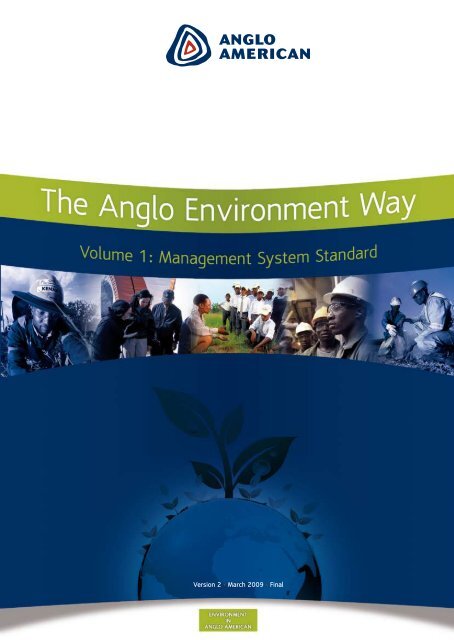
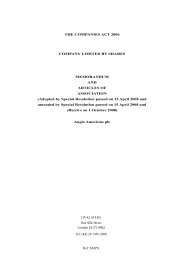
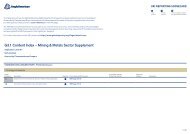
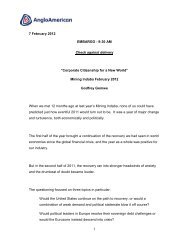


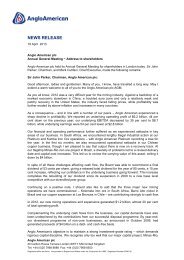
![English PDF [ 189KB ] - Anglo American](https://img.yumpu.com/50470814/1/184x260/english-pdf-189kb-anglo-american.jpg?quality=85)
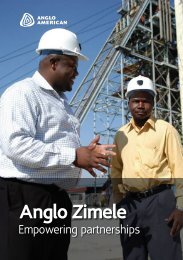



![pdf [ 595KB ] - Anglo American](https://img.yumpu.com/49420483/1/184x260/pdf-595kb-anglo-american.jpg?quality=85)
![pdf [ 1.1MB ] - Anglo American](https://img.yumpu.com/49057963/1/190x240/pdf-11mb-anglo-american.jpg?quality=85)
